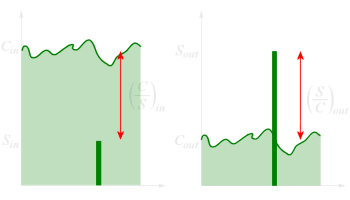Subclutter Visibility and Improvement Factor

Figure 1: Ratio between signal S and clutter C at the input and output of MTI
Subclutter Visibility and Improvement Factor
Radar performance in clutter is summarized by two parameters; improvement factor If and subclutter visibility.
The phrase Subclutter Visibility (SCV) describes the radar's ability to detect non-stationary targets embedded in a strong clutter background with a given signal-to-clutter ratio (SCR), for some probabilities of detection and false alarm. It is often used as a measure of of the effectiveness of moving-target indicator radar, equal to the ratio of the signal from a fixed target that can be canceled to the signal from a just visible moving target.
The Improvement factor If is defined as the signal-to-clutter ratio at the output of the clutter filter divided by the signal-to-clutter ratio at the input of the clutter filter, averaged uniformly over all target velocities of interest. This definition includes the signal gain as well as the clutter attenuation. With respect to Doppler frequency, the Improvement factor can be expressed as:
| If = (S/C)out · (C/S)in = | Cin | · Gav | where | Cin = strength of clutter at clutter filter input Cout = strength of clutter at clutter filter output Gav = average filter gain for moving targets |
(1) |
| Cout |
The subclutter visibility is expressed as the ratio of the improvement factor to the minimum MTI output given signal-to-clutter ratio (SCR) required for proper detection for a given probability of detection.
| SCV = | If | SCV = Sub-Clutter Visibility SCR = Signal-to-Clutter Ratio |
(2) |
| (SCR)out |
For example, a given radar set with 20 dB subclutter visibility will be able to detect moving targets whose returns are houndred times smaller than those of clutter. The subclutter visibility is typically in the region of 30 dB, enabling targets with small radar cross-sections (typically 0.5 m2) to be detected even in the presence of heavy ground, sea and rain clutter.
When comparing different radar systems' performances on the basis of subclutter visibility, one should use caution since the amount of clutter power is dependent on the radar resolution cell (or volume), which may be different from one radar to another. Thus, only if the different radars have the same beamwidths and the same pulse widths, can subclutter visibility be used as a basis of performance comparison.
The phrase Superclutter Visibility describes the ability of radar (or radar operator) to recognize an echo-signal of interest that is stronger than the clutter, mostly in radar without a dedicated moving target detection. For example, if a cheap one naval radar detects a ship at sea clutter environment.
If radar system can resolve the areas of strong and weak clutter within its field of view, then the phrase Interclutter visibility (ICV) describes the ability to recognize this echo of interest in the weak or clear areas between strong clutter patches. In this case, one uses mostly a plotted or electronically Cluttermap.

